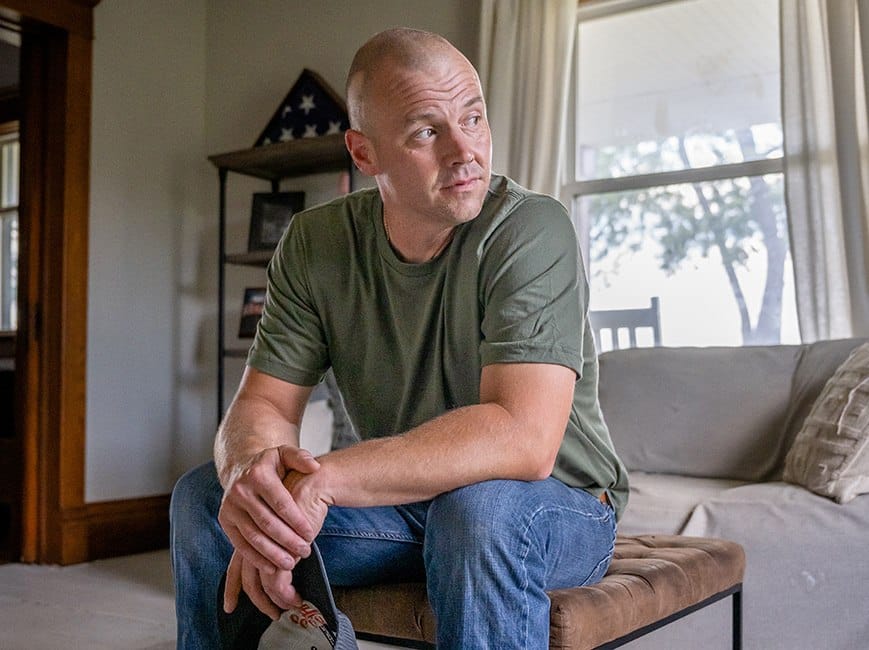Fentanyl Recovery Programs in Alabama
Bradford at Warrior offers comprehensive fentanyl addiction treatment in the peaceful Appalachian foothills near Birmingham. Our proven approach combines medical expertise with compassionate care to guide you toward lasting recovery.
Breaking Free from Fentanyl Addiction
Fentanyl addiction represents one of the most serious challenges facing individuals and families today. This synthetic opioid, which can be up to 100 times more powerful than morphine , has transformed the landscape of substance abuse treatment. At Bradford at Warrior, located in the serene foothills of the Appalachian Mountains near Birmingham, Alabama, we understand the unique complexities of fentanyl addiction and provide specialized care designed to address every aspect of this devastating condition.
The journey into fentanyl addiction often begins innocently. Many individuals first encounter this substance through legitimate medical prescriptions for severe pain management. Others may unknowingly consume fentanyl when it is mixed with other drugs they believe they are purchasing, such as heroin, cocaine, or counterfeit prescription medications . This deceptive presence in the drug supply has made fentanyl addiction a widespread concern that affects people from all walks of life, regardless of their original intentions or circumstances.
What sets fentanyl apart from other opioids is not just its extraordinary potency, but also the speed with which physical dependence can develop. The drug works by flooding the brain’s opioid receptors, creating an intense but short lived euphoria that quickly gives way to powerful cravings for more. This cycle can establish itself within days or weeks of first use , making early intervention absolutely critical for successful treatment outcomes.
At Bradford at Warrior, we approach fentanyl addiction as the complex medical condition it truly is. Our treatment philosophy recognizes that addiction affects not just the individual, but entire family systems and communities. We believe that recovery is not only possible but achievable for everyone who seeks help, regardless of how long they have struggled with addiction or how many previous attempts at sobriety they may have experienced .

Our facility, nestled in the natural beauty of Alabama’s landscape, provides an ideal setting for healing and reflection. The peaceful environment, combined with our evidence-based treatment approaches and experienced clinical team, creates the optimal conditions for individuals to focus entirely on their recovery without the distractions and triggers of their everyday environment. We have been serving the Alabama community and beyond since 1977 , building a reputation for excellence in addiction treatment that families can trust during their most difficult moments.
Recognizing Fentanyl Use and Addiction
Early recognition of fentanyl use can literally save lives. Because of the drug’s extreme potency and the narrow margin between an effective dose and a potentially fatal overdose, understanding the warning signs becomes a matter of urgent importance. At Bradford at Warrior, we work closely with families to help them identify these signs and take appropriate action before a crisis occurs.

Observable Physical Changes
Early recognition of fentanyl use can literally save lives . Because of the drug’s extreme potency and the narrow margin between an effective dose and a potentially fatal overdose, understanding the warning signs becomes a matter of urgent importance . At Bradford at Warrior, we work closely with families to help them identify these signs and take appropriate action before a crisis occurs.
Breathing changes are among the most dangerous signs to watch for. Fentanyl users may breathe very slowly, shallowly, or irregularly . In some cases, breathing may stop entirely for short periods. The skin may take on a bluish tint, particularly around the lips, fingernails, or other areas where blood vessels are close to the surface. These respiratory symptoms require immediate medical attention as they can indicate a life threatening overdose in progress .
Other physical signs include dramatically constricted pupils that remain small even in low light conditions, unusual changes in body temperature where the person may feel very cold or hot to the touch, and gastrointestinal issues such as severe constipation, nausea, or loss of appetite . Many users also experience significant weight loss as the drug suppresses normal eating patterns and the lifestyle associated with addiction often neglects basic nutritional needs .
Behavioral and Psychological Indicators
The behavioral changes associated with fentanyl addiction can be just as telling as the physical symptoms, though they may develop more gradually . Individuals may begin to withdraw from family relationships, friendships, and activities that were once important to them. This social isolation often stems from shame about their drug use, as well as the practical need to conceal their addiction from others .
Cognitive function typically becomes impaired, with users experiencing difficulty concentrating, making decisions, or remembering important information . They may seem confused or disoriented, even when not actively under the influence of the drug. Sleep patterns often become severely disrupted, with individuals staying awake for extended periods followed by long periods of deep sleep .
As the addiction progresses, behavioral changes may become more dramatic and concerning. Individuals may begin engaging in risky or illegal activities to obtain money for drugs, such as stealing from family members, selling personal possessions, or associating with dangerous individuals . They may lie about their whereabouts, make excuses for their behavior, or become defensive when questioned about their activities .

Critical Overdose Warning Signs
The Fentanyl Crisis in Alabama
Alabama has experienced both the devastating impact of the fentanyl epidemic and some encouraging recent developments in addressing this crisis. Understanding the scope of the problem helps illustrate why specialized treatment programs like those offered at Bradford at Warrior are so essential for our communities.
18.2%
Decline in overdose deaths between July 2023 and July 2024
269%
Increase in overdose death rate from 2000 to 2018
#1
Alabama ranks first nationally for opioid dispensing rate
114%
Increase in monthly drug overdose deaths since January 2015
The recent 18.24 percent decline in overdose deaths between July 2023 and July 2024 represents a significant victory in Alabama’s fight against the fentanyl crisis . This improvement reflects the combined efforts of healthcare providers, law enforcement, community organizations, and treatment centers like Bradford at Warrior working together to address this epidemic from multiple angles .
However, the statistics also reveal the magnitude of the challenge that Alabama continues to face. The state holds the unfortunate distinction of having the highest opioid dispensing rate in the nation, with 71.4 prescriptions per 100 persons in 2023 . This high rate of prescription opioid availability has contributed to the development of opioid use disorders, with many individuals eventually transitioning to illicit substances like fentanyl when prescription medications become unavailable or too expensive .
The historical data shows just how dramatically the crisis has escalated over the past two decades. The 269 percent increase in overdose death rates from 2000 to 2018 represents one of the most significant public health challenges in Alabama’s history . More recently, the 114 percent increase in monthly drug overdose deaths since January 2015 demonstrates how rapidly the situation has deteriorated, particularly with the introduction of fentanyl into the illegal drug supply .

Rural areas of Alabama have been particularly hard hit by the opioid crisis, often lacking access to specialized treatment resources . This geographic challenge makes facilities like Bradford at Warrior, which serves clients from throughout Alabama and surrounding states, especially important for ensuring that individuals in underserved areas can access the comprehensive care they need .

The Alabama Department of Mental Health has implemented various initiatives to combat the crisis, including expanded access to naloxone , increased funding for treatment programs , and enhanced data collection systems to better track overdose patterns . These state level efforts complement the work being done by treatment providers to create a more comprehensive response to the fentanyl epidemic .
Understanding Fentanyl’s Impact on Health
The health consequences of fentanyl use extend far beyond the immediate risk of overdose, though that risk remains the most pressing concern . At Bradford at Warrior, we help our clients understand the full spectrum of health effects associated with fentanyl use, both to motivate their commitment to recovery and to address the various medical issues that may arise during treatment .
Immediate Health Risks
The most immediate and dangerous effect of fentanyl use is respiratory depression, where the drug suppresses the central nervous system to the point where breathing becomes dangerously slow or stops entirely . This effect can occur with any dose of fentanyl, but the risk increases dramatically with higher doses or when fentanyl is combined with other depressant substances like alcohol or benzodiazepines .

Cardiovascular effects are also immediate and concerning. Fentanyl can cause significant drops in blood pressure and heart rate, potentially leading to fainting, falls, or more serious cardiac events . Users may experience chest pain, irregular heartbeat, or circulation problems that can result in cold, clammy skin and poor wound healing .
Gastrointestinal effects typically include severe nausea and vomiting, which can be particularly dangerous if the person is unconscious or semi conscious, as they may aspirate vomit into their lungs . Severe constipation is also common and can lead to serious complications if left untreated. Many users also experience a complete loss of appetite, leading to rapid weight loss and nutritional deficiencies .
Long Term Physical Consequences
Chronic fentanyl use creates a cascade of health problems that can affect virtually every organ system in the body . The respiratory system may suffer permanent damage from repeated episodes of oxygen deprivation, potentially leading to chronic breathing problems and increased susceptibility to respiratory infections .
The cardiovascular system faces ongoing stress from the drug’s effects on heart rate and blood pressure regulation . Long term users may develop heart rhythm disorders, weakened heart muscle, or increased risk of heart attack and stroke . For those who inject fentanyl, the risk of developing serious heart infections, collapsed veins, and blood clots becomes a constant concern .
Neurological effects of chronic fentanyl use can be particularly devastating. The brain’s reward system becomes fundamentally altered, making it extremely difficult for individuals to experience pleasure from normal activities . Memory problems, difficulty concentrating, and impaired decision making abilities may persist long after drug use stops, though many of these effects can improve with sustained sobriety and appropriate treatment .
The immune system also suffers under the stress of chronic opioid use, leaving individuals more vulnerable to infections and slower to heal from injuries or illnesses . This compromised immune function, combined with the lifestyle factors often associated with addiction, can lead to a wide range of secondary health problems that require ongoing medical attention .
Mental Health and Emotional Effects
The psychological impact of fentanyl addiction extends far beyond the physical dependence on the drug itself . Many users develop severe depression, anxiety, and other mental health conditions that may persist even after the physical withdrawal symptoms have resolved . The shame and guilt associated with addiction can create additional psychological barriers to recovery that require professional intervention to address effectively .
Cognitive function may be impaired for months or even years after stopping fentanyl use . Users may struggle with memory problems, difficulty processing information, and challenges with executive function skills like planning and organization . These cognitive effects can make it difficult to maintain employment, relationships, and other important aspects of daily life, highlighting the importance of comprehensive treatment that addresses these issues .

Comprehensive Recovery at Bradford at Warrior
At Bradford at Warrior, our approach to fentanyl addiction treatment is built on decades of experience and the latest advances in addiction medicine. We understand that successful recovery requires addressing not just the physical dependence on fentanyl, but also the underlying psychological, social, and spiritual factors that contribute to addiction. Our comprehensive program is designed to provide individuals with all the tools and support they need to achieve lasting sobriety.
1 – Comprehensive Assessment and Medical Evaluation
Every individual who enters our program begins with a thorough assessment conducted by our multidisciplinary team of medical professionals, addiction specialists, and mental health counselors . This evaluation examines not only the extent of the fentanyl addiction but also any co occurring mental health conditions, medical complications, and social factors that may impact treatment . We use this information to develop a personalized treatment plan that addresses each person’s unique needs and circumstances .
2 – Medically Supervised Detoxification
For individuals experiencing withdrawal symptoms, we provide safe, comfortable medical detoxification services . Our medical team closely monitors each client throughout the detox process, using appropriate medications to manage withdrawal symptoms and prevent complications . We understand that fentanyl withdrawal can be particularly challenging, and we are committed to making this process as comfortable and safe as possible .
3 – Medication Assisted Treatment Programs
We utilize FDA approved medications such as methadone, buprenorphine, and naltrexone as part of our comprehensive treatment approach . These medications help reduce cravings, prevent withdrawal symptoms, and block the euphoric effects of opioids, allowing individuals to focus on the psychological and behavioral aspects of recovery . Our medical team carefully monitors each client’s response to medication and makes adjustments as needed to optimize treatment outcomes .
4 – Individual and Group Therapy
The foundation of our treatment program consists of evidence-based therapeutic interventions delivered through both individual and group settings . We utilize approaches such as cognitive behavioral therapy, dialectical behavior therapy, and motivational interviewing to help clients understand the root causes of their addiction and develop effective coping strategies . Our experienced therapists specialize in addiction treatment and provide compassionate, non judgmental support throughout the recovery process .
5 – Family Therapy and Support Services
We recognize that addiction affects entire families, not just the individual struggling with substance use . Our family therapy programs help repair damaged relationships, improve communication patterns, and educate family members about addiction and recovery . We also provide support and resources for family members who may be dealing with their own trauma and stress related to their loved one’s addiction .
6 – Holistic Wellness and Life Skills Training
Recovery involves much more than simply stopping drug use. Our program includes holistic wellness activities such as fitness programs, nutritional counseling, mindfulness training, and recreational therapy . We also provide life skills training to help clients develop the practical abilities they need to maintain their sobriety and rebuild their lives, including job search assistance, financial planning, and social skills development .
7 – Continuing Care and Alumni Support
Recovery from fentanyl addiction is a lifelong journey that extends far beyond initial treatment . We work with each client to develop a comprehensive continuing care plan that may include ongoing therapy, support group participation, sober living arrangements, and vocational or educational support . Our alumni program provides ongoing connection and support for graduates of our program, helping them maintain their sobriety and continue growing in their recovery .

Our treatment philosophy is grounded in the understanding that addiction is a chronic medical condition that requires ongoing management and support. We treat each person with dignity, respect, and compassion, recognizing their inherent worth and potential for recovery. Our team is committed to providing the highest quality care in a supportive, therapeutic environment that promotes healing and personal growth.
Bradford at Warrior is situated on a beautiful campus in the foothills of the Appalachian Mountains, providing a peaceful and inspiring environment for recovery. Our facilities include comfortable residential accommodations, modern medical and clinical spaces, fitness and recreational areas, and peaceful outdoor spaces where clients can reflect and reconnect with nature. This serene setting, combined with our comprehensive treatment approach, creates the ideal conditions for healing and transformation.
Begin Your Recovery Journey Today
If you or a loved one is struggling with fentanyl addiction, know that help is available and recovery is possible. Bradford at Warrior has been providing hope and healing to individuals and families affected by addiction since 1977. Our compassionate team is ready to guide you through every step of the recovery process with the expertise and support you deserve.V
A New Beginning
“I came to Bradford because I needed help. They gave me what I needed. They gave me a safe, therapeutic environment to start the journey of recovery with support and guidance. I live an amazing life that started with the tools I learned at Bradford.”
– William M., Bradford Alumnus

